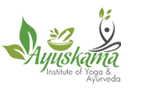What is Panchakarma?
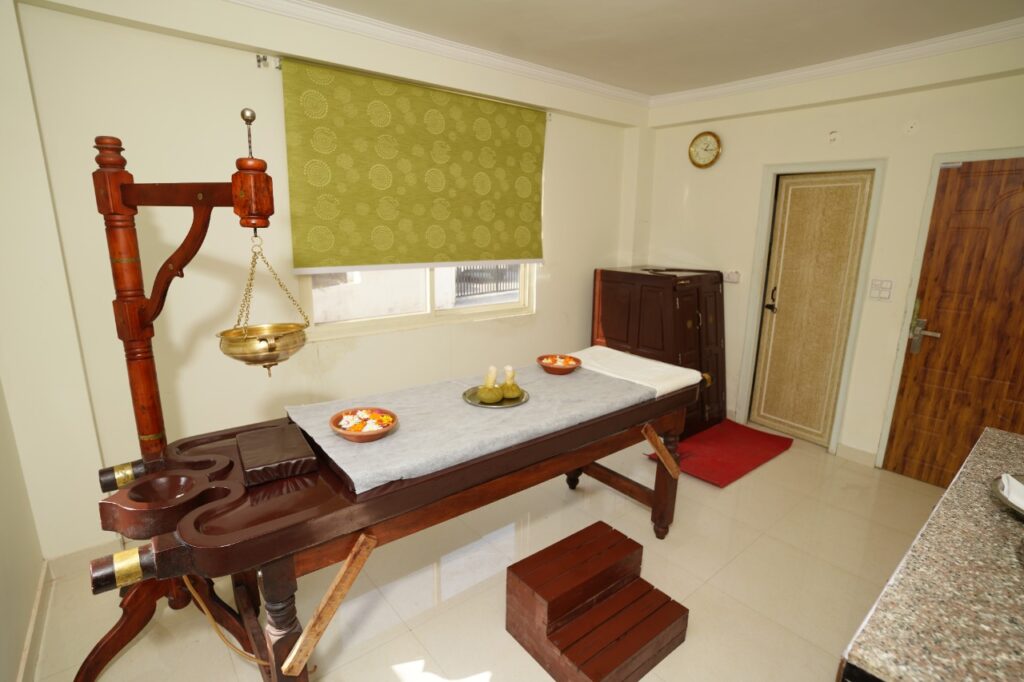
Panchakarma is a Sanskrit word that means “five actions” or “five treatments”. It is an ancient Indian medical procedure used to cleanse the human body of toxic materials left by disease and poor nutrition. It also has different therapeutic roles for a number of diseases.
Normally, our body has the natural ability to efficiently process and remove these waste materials, including the vitiated doshas. However, due to our dietary carelessness, poor exercise patterns, erratic lifestyle, and genetic predisposition, the digestive enzymes, metabolism, hormones, and agnis which regulate the body’s internal homeostasis become disorganized.
This can lead to the accumulation and spread of toxins throughout the physiology resulting in diseases and ailments. In Ayurveda, this toxin waste matter is called ama. It is a foul-smelling, sticky, harmful substance that needs to be completely evacuated from the body.
Ayurveda recommends Panchakarma as a seasonal treatment for maintaining mental and physical hygiene and balance.
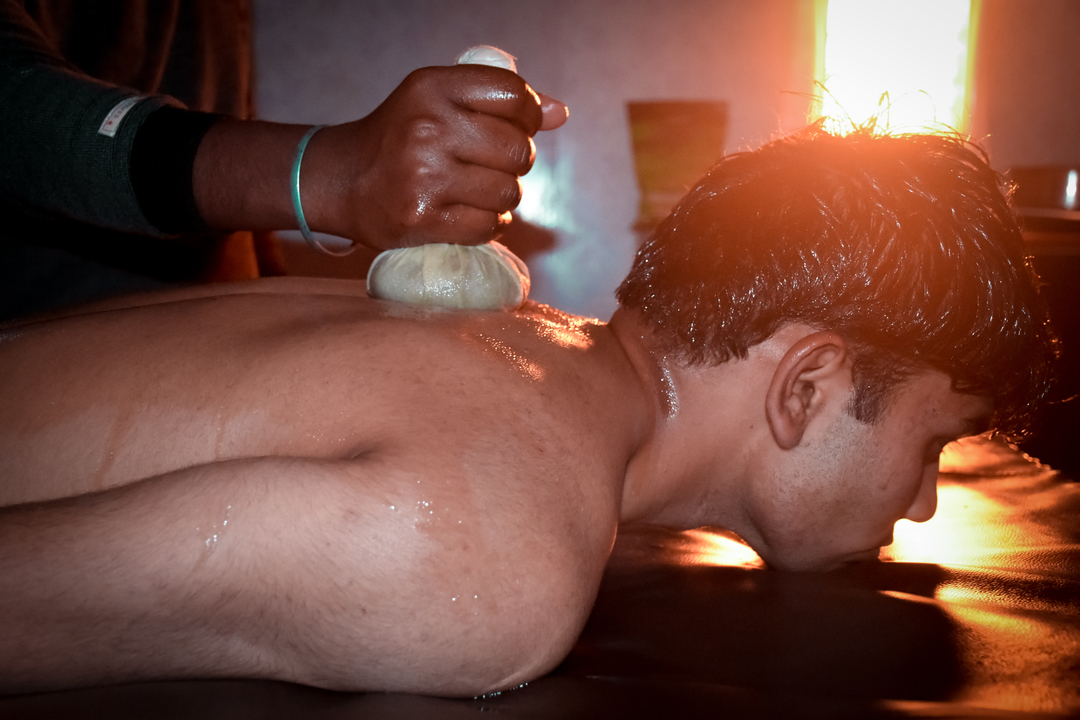
Panchakarma is a five-fold therapy. It is a highly individualized procedure that is curated based on the needs of the individual depending on the Ayurvedic constitutional type, doshic imbalances, age, digestive strength, immune status, and many other factors.
Depending on each individual’s needs, all or only one of the five therapies are utilized. These procedures must be administered by specially trained therapists in a proper sequence for a specified period of time.
Although Panchakarma is, for the most part, a delightful and comfortable therapy, there can be periods of discomfort associated with the profound release of toxins which does occur. It is therefore essential that the therapy is supervised by a knowledgeable expert who can recognize the signs of properly and improperly administered Panchakarma. Fortunately, these signs were meticulously recorded by our ancient vaidyas (physicians).
Shodhana (Purification) and Shamana (Pacification)
Like all medical procedures, Panchakarma Therapy always must begin with an initial consultation by a qualified Ayurvedic doctor who can determine the individual’s Prakriti (constitutional type), the nature of the health problem (if any), and the appropriate degree of intensity of the prescribed therapies. There are certain special circumstances in which panchakarma should be administered only with strict medical supervision: recovering drug addiction, alcoholism, hypertension, diabetes, Asthma, Arthritis and eating disorders are the most common.
Panchkarma courses in Rishikesh by Ayuskama is being done by Professional Ayurveda doctors. who very well understand the Process and different body types so treatment given has its results on the body.
The Panchakarma Process: Panchakarma treatments are divided into three phases of detoxifications:
- Purvakarma is preparation for cleansing
- Pradhankarma or Main course of Panchakarma consists of five cleansing procedures
- Pashchatkarma, or aftercare, are therapies applied after cleansing
A. Purvakarma: Consists of the following steps:
1. Snehan (oleation therapy):
Internal snehan: medicated oils and ghee (clarified butter) are used. This help eliminates impurities so that elimination becomes easier. External snehan: consists of different kinds of massage using medicated oils.
2. Sweden (sweating):
Sweating is done shortly after the message. This is normally done in a sweatbox.
The Purvakarma procedures are often under-appreciated in the grand scheme of the proper administration of Panchakarma. The general purpose of the Poorvakarma Therapies is to begin to loosen, liquefy, and move the vitiated doshas from their abnormal sites in peripheral tissues to the appropriate central site within the alimentary canal.
B. Pradhan karma: The main course consists of five processes as follows:
- Vamana (use of emetics): Artificial vomiting is induced using herbs. It is usually indicated for people with ‘Kapha’ (phlegm) disorders.
- Virechan (use of laxatives): Different purgatives are used depending upon a person’s constitution and disease. It is normally used to eliminate excessive Pitta (fire) from its site in the small intestines.
- Basti: A colon irrigation procedure to first cleanse the colon (Niruh Basti), and then restore (Asthapan) the function of the colon with medicated enemas.
- Nasya (Nasal administration): Medicinal oils or herbal mixtures are inhaled or used as drops (mixed with oils or ghee) to clear the congestion in the sinuses. It is also good for balancing the prana (air) in Vata.
- Rakta Mokshana (bloodletting): We recommend blood donations. Researchers at the Kansas University Medical Center in Kansas City have found that non-smoking men who donated blood had a 30% reduced risk for cardiovascular events such as heart attack, bypass, and stroke than non-donors. (The British Medical Journal, March 15, 1997 Volume 314, 793-794).
See More – Ayurveda Massage Course
Therapeutic Vomiting (Vamana)
This treatment is used when there is congestion in the lungs causing repeated attacks of bronchitis, cough, cold or asthma. The objective of the therapy is to induce vomiting to get rid of the mucus causing excess Kapha. On the morning of the vamana., Kapha aggravating foods such as basmati rice and yogurt with salt is given to further aggravate the Kapha. The application of the heat to the chest and back will help liquefy kapha. A drink consisting of madanaphalam, licorice and honey, is given to the patient. (Other substances used include salt and cardamom) Vomiting will either occur spontaneously or is induced by rubbing on the tongue. 4-8 vomiting is the target. After vomiting the patient will feel very comfortable; most of the congestion, wheezing and breathlessness will disappear along with the clearing of the sinus.
Therapeutic vomiting is used for a cough, cold, symptoms of asthma, fever, nausea, loss of appetite, anemia, poisoning, skin diseases, diabetes, lymphatic obstruction, chronic indigestion, edema (swelling), epilepsy (between attacks), chronic sinus problems and for repeated attacks of tonsillitis.
Purgation Therapy (Virechana, Laxative Therapy)
Virechana is the cleansing of the pitta and the purification of the blood toxins. Generally, it is administered three days after the Vamana treatment but this may vary. If Vamana therapy is not needed, Virechana can be administered directly after purvakarma. Virechan cleanses the sweat glands, small intestine, colon, kidneys, stomach, liver and spleen. A number of effective and safe herbs can be used as a laxative. This includes senna, prune, bran, flaxseed husk, dandelion root, psyllium seed, cow’s milk, salt, castor oil, raisins and mango juice. When taking these laxatives, it is important to adhere to the restricted diet. Virechana is used for the treatment of skin diseases, chronic fever, piles, abdominal tumors, worms, gout, jaundice, gastrointestinal problems, constipation and irritable bowel syndrome.
Enema (Basti)
Medicated enemas are used for various specific reasons. In general, this treatment is used topromote elimination of the loosened Vata dosha out through the rectum. There are many specific enemas listed in Ayurveda. Basti involves introducing medicinal substances such as herbalized oils and other herbal decoctions in a liquid medium into the rectum. Basti is especially good for vata disorders. It alleviates constipation, distention, chronic fever, the common cold, sexual disorders, kidney stones, heart pain, vomiting, backache, neck pain and hyperacidity. Such vata disorders as sciatica, arthritis, rheumatism, neurodegenerative conditions, and gout can also be treated by Basti. There are about 80 vata-related disorders in Ayurveda. About 80 percent of them can be treated with medicated enemas.
Since vata is mainly located in the colon and bones, the medication is administered rectally.
Nasya (Nasal administration; Errhine Therapy
This treatment involves the administration of herbalized oils and liquids into the nostrils. It is useful for the treatment of kapha-oriented problems, of ear, eyes, nose and throat disorders such as a migraine, sinusitis, catarrh, and bronchitis. The nose is the gateway to the brain and to consciousness. Prana or vital energy enters the body through breath taken in through the nose. Nasal administration of medication helps to correct the disorders of prana affecting the higher cerebral, sensory and motor functions. Nasya is indicated for dryness of the nose, sinus congestion, hoarseness, migraine headache, neurodegenerative conditions (i.e. multiple sclerosis), convulsions and certain eye and ear problems.
Blood Letting (Rakta Moksha)
Blood letting is used to eliminate toxins that are absorbed into the bloodstream through the gastrointestinal tract. This process purifies the blood. It is used for disorders such as repeated attacks of skin disorders such as urticaria, rash, eczema, acne, scabies, leucoderma, chronic itching and hives. It is also often effective for enlarged liver and spleen, hemochromatosis, and for gout. Blood letting, which should only be administered by a qualified physician, is useful to relieve several pitta disorders such as acne and rash. If administered properly, it stimulates the antitoxic substances in the blood stream, thus developing the immune mechanism in the blood system. Do not administer blood letting in cases of anemia, edema, weakness or to very old and very young persons.
Instructions about Panchakarma:

Other Miscellaneous Therapies of Panchkarma :
Abhyanga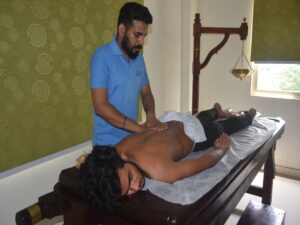
This is a special type of oil massage in which hand strokes are made according to the disease. It enhances blood flow and is usually given as pre-procedure to many therapies as well as a separate therapy in itself.
Indication: Obesity, rheumatism, blood pressure, spondylitis, weakness, stress and strain, rejuvenations, relaxation, vigor & vitality.
Pizhichil
Slow stream of warm medicated oil applied/poured all over the body along with a gentle massage. The time duration is generally 45-60 minutes per session. Indications: Rheumatic disease, arthritis, spondylitis, paralysis, hemiplegia, paraplegia, sexual weakness, nervous weakness & other diseases.
Shirodhara (Types: Thaila/Thakra/Kseer/Kashay)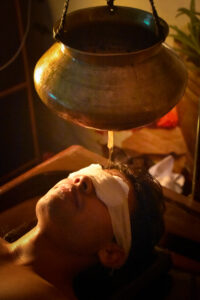
In this procedure, herbal oils, medicated buttermilk or milk or decoction etc are poured slowly on the forehead. The time duration is 20-45
minutes. Indication: Insomnia, mental tension, headache, migraine, sinusitis, certain skin diseases, stress & strain, depression, hair care etc.
Navarkizhi (shashtik pinda swedan)
In this process, the whole body or any specific part there of, is made to perspire by the external application of certain medicated milk puddings tied up in the form of boluses. The time duration is 45-60min 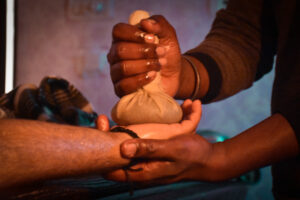 Indication: Emaciation of limbs, skin diseases, rheumatic complaints etc.
Indication: Emaciation of limbs, skin diseases, rheumatic complaints etc.
Udvartan
This is a typical massage with herbal powders useful for burning fat under the skin. It helps to lose weight, exfoliates dead skin. The time duration is 30-50min.
Indication: Obesity, Hemiplegia, Paralysis, Skin Ailments, Impaired Blood Circulation.
Shirobasti 
Lukewarm herbal oils are poured into a cap fitted on the head and stagnated for a prescribed time according to the patient’s condition. The time duration is 30-45minutes.
Indication: Facial Paralysis, dryness of nostrils, mouth & throat, severe headaches, burning sensation of head & other Vata-borne Diseases, Hairfall, Thinning and greying of Hair etc.
Kati Vasti 
For this, specially prepared warm medicated oil is kept over the lower back within the herbal paste boundary. The time duration is 20-30min per session.
Indication: All types of back pain & spinal pain, slip disc, sciatica, spondylitis etc.
Thala Dharan
Special powder mixed with oil is applied on top of the head. The time duration is 30min per session
Indication: a Migraine, facial paralysis, heat stroke, high B.P. etc.
Karnapoorana 
This therapy consumes 15-20 minutes. It involves filling the ears with medicated oil to drain, wash the ear.
Indications: Dry nose/ears, earache, ear wax, tinnitus, tingling sensation in the ears etc.
Akshitarpan/Netratarpan 
It is a cleansing process for the eyes, which gives a cooling effect to the eyes, prevents eye diseases and strengthens optic nerve, also improves eyesight. This procedure takes 15-25 minutes.
Indications: Eyestrain due to TV, computer, pollution, tired eyes, watering of eyes, dimness of vision at night. It helps in preventing early formations of cataracts.
Mukhalepam
In this procedure, the herbal paste is applied to the face for the treatment of wrinkles, dry or oily skin, blemishes, acne etc.
Hridya Basti/Uro basti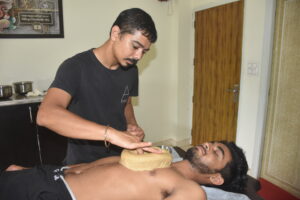
It is a unique treatment for heart and chest diseases. In this medicated oil, ghrit or decoction of herbs is placed into the rim of urad flour.
Indication: Useful for the strengthening of the heart, angina, asthma and other respiratory problems.
Janu Basti
In this treatment, medicated oils, ghrit is placed into the rim of urad flour made at the knee joint Indications: Osteoarthritis, Rheumatoid Arthritis, Gout etc.
Details of Ayurveda Panchakarma Treatment Packages.
The total package….
Package (including meals, non-AC accommodation & Ayurveda treatments) is 5000 Rs per day.
Package (including meals, non-AC accommodation & Ayurveda treatments) for two people is 8000 Rs per day.
Note – 1000 INR /per day will be extra charged for A/C rooms.
Note: (For Indian People) To confirm your reservation please deposit 2500 Rs in advance via Google pay/phone pay (9917317388), Paytm (7351344622) so that we can reserve your seat.
Note: (For foreigner people) To confirm your reservation please deposit 110 USD (including $10 PayPal tax) in advance via PayPal or transfer wise so that we can reserve your seat.
PayPal ID: ayuskamarishikesh@gmail.com
Bank Details:
Bank Name: Axis Bank
Name: AYUSKAMA AYURVEDA AYUR YOGA
Account No: 915020023558802
Swift Code: AXISINBB093
IFSC Code: UTIB0000156
Branch Code: 156
